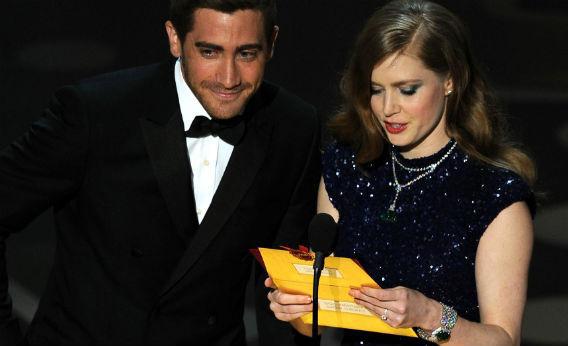The 84th annual Academy Awards will be on Sunday. As always, the winners will be revealed when a movie star pulls a small card out of an envelope. What, exactly, is written on those cards?
Everything the presenter has to say. Oscar presenter cards say, in sans-serif all-caps, “AND THE OSCAR GOES TO …” followed by the name of the winner on the next line. For categories like best actor or actress, the winner’s name appears above the name of the film in which he or she performed. For best picture, the movie name appears first in quotation marks, followed by the names of the producers, a comma, and then the word “producers.” Basically, if the presenter opens the envelope and reads all of the text, from top to bottom, she will have done her job.
Until last year’s ceremony, the envelope and presenter card were a simple cream color. Then the Academy of Motion Picture Arts and Sciences hired a designer to jazz up the stationery. Now the envelope is gold with a red lining dotted with small Oscar statuettes. The envelope is sealed with a sticker carrying the initials of PricewaterhouseCoopers, the accounting company that has been tabulating the votes for 78 years. (Glue would fasten the envelope more securely, but it would also cause an awkward pause as the presenter struggled with the seal.) The card itself is still mostly off-white, but the words “AND THE OSCAR GOES TO …” are now in raised gold lettering instead of simple black print.
The names of some of this year’s nominees are difficult to pronounce (click here for Slate’s handy pronunciation guide), and the presenter card does not include a phonetic spelling guide. At Saturday’s rehearsal, presenters get a few chances to practice pronunciation. They often make a recording of themselves reading the nominees, which plays over the film clips during the Sunday’s ceremony in some categories. They also open a practice envelope and read a card that names a winner “for this rehearsal only.”
Oscar voting hasn’t yet entered the digital age. Academy members vote on paper ballots by placing an X or checkmark next to the nominees’ names, then mail the ballot to PricewaterhouseCoopers. While the 2000 presidential election demonstrated the perils of paper ballots, there hasn’t been a significant problem determining voter intent. Voters who scribble over their original mark or otherwise make a mess typically handwrite an explanation to make their vote clear. (Sometimes they add “Hi PwC” or some other cute note in the margins.) The Academy plans to launch online voting next year.
Two head accountants supervise the count. They divide the ballots among four assistants, none of whom have enough ballots to figure out the winners on their own. The two partners then add up the assistants’ totals to determine the winners.
The head accountants then stuff two complete sets of presenter cards into envelopes, and place them into identical briefcases. (The stationers prepare presenter cards for every nominee, just as both teams in a World Series have championship hats and t-shirts made in advance of the game. The loser’s cards are destroyed.) The briefcases remain in a vault until the day of the show. The two accountants each carry one briefcase to the theater, traveling in separate cars. The last thing presenters do before striding into the spotlight is receive the envelope from a PwC accountant, who is standing just offstage.
The accountants also memorize the names of the winners. This extra step became critical during the 1996 awards, when Sharon Stone and Quincy Jones presented back-to-back awards. The winner of the first award accidentally walked off stage with the envelope containing the name of the second winner. Stone ad-libbed while Jones hustled over to learn the winner’s name from the PwC partner.
This level of security might seem more appropriate for nuclear launch codes than movie awards, but the Oscars faced suspicions in the early years that studio heats were stuffing the ballot boxes. The Academy brought in a major accounting firm to address that problem in 1935.
Got a question about today’s news? Ask the Explainer.
Explainer thanks Steve Pond, awards columnist for TheWrap, and Rick Rosas of PricewaterhouseCoopers.
